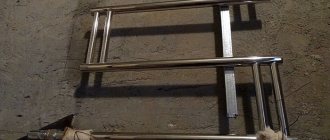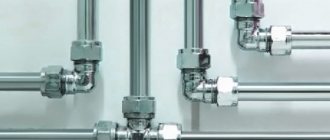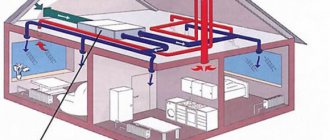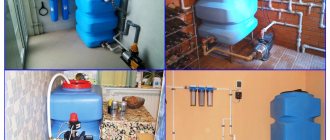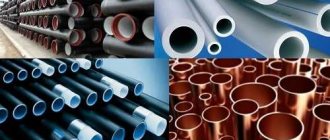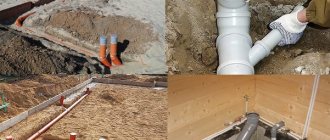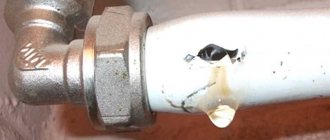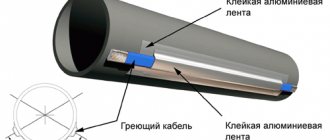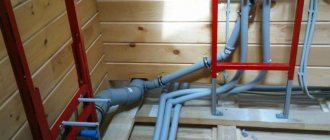Year after year, polypropylene pipes are becoming more and more popular, since the list of industries for their application is very large and is constantly growing: agriculture, mechanical engineering, sewerage systems, water supply, heating, etc. These plumbing products have certain standards. In this article we will analyze the diameter of polypropylene pipes for water supply, including the outer and inner diameters, taking into account the thickness and density of the polymer.
The main advantage of PP pipes is the balance of price, quality and safety margin. In addition, polypropylene pipes for heating or plumbing, unlike their steel counterparts, do not conduct electricity, so they are safe for human health. Another advantage why it is worth using polypropylene for plumbing is its complete resistance to corrosion. This material also has a pleasant appearance.
Eco-friendly polypropylene pipes for drinking water supply from European manufacturers are a guarantee of long service life and safety of polypropylene pipelines.
What influences the indicators
The choice of characteristics for equipment in a private home depends on the load on the system. The diameter of the pipes is affected by the pressure in the water supply. The higher the indicator, the larger size should be used. A thin stream from the tap will be the result of inappropriate parameters with low pressure. When capacity is exceeded, breakthroughs and accidents occur.
The choice of pipe diameter depends on the type of water supply. In a private house, 2 types of connections are possible:
- Mainline. The liquid to the cottage comes from the central system. To ensure that all consumers have moisture, the equipment parameters should not exceed 32 mm.
- Autonomous. Moisture enters a private house from a well. The characteristics are selected from the operating characteristics of the building.
The diameter of the water pipe is affected by the number of intake points. Moisture consumption in a private house is greater than in a city apartment. If the characteristics of the equipment are not suitable, then when you open the tap or turn on the washing machine, the pressure in other parts of the cottage decreases.
Design for a country house Source 1-teplodom.ru
The diameter of the pipe depends on the length of the water supply. Large elements are installed in an extended system. If the parameters at the dacha do not exceed 10 m, then pipes up to 20 mm are sufficient. In a multi-storey cottage, the equipment footage reaches 30-50 m, so the thickness of the elements varies between 25-50 mm.
The diameter of the pipe is also affected by the complexity of the water supply system. Each bend reduces the pressure in the system. When the washing machine and shower operate simultaneously, the pressure decreases throughout the entire structure. Experts recommend taking conductive elements with a reserve, preventing possible problems.
The diameter of the water supply pipes in a private house depends on the number, type and cross-section of all connected components. Installation of pumping equipment, meters and fittings narrows the path of the liquid. The more objects in the system, the greater the hydraulic losses. To neutralize the problem, experts recommend trying to reduce the number of nodes.
What affects the diameter Source trubyda.ru
The diameter and wall thickness of the pipes depend on the purpose of use. For cold water supply, the parameters of plastic models vary from 1.9 to 5.8 mm. For hot readings there are from 3.4 to 10.5 mm.
The characteristics in the passport consist of an external (outer) circumference and an internal value.
Manufacturers of water pipes often indicate the diameter in inches, the parameters of which in the traditional metric system are 25.4 mm. Sometimes on the packaging the cross section is written with an inclined line. The first number is responsible for the external characteristics, the second is the wall thickness. The internal size is determined by calculation.
Pipe products made of polymers
Today, other types of pipes are used more often to provide water supply in an apartment. At a very affordable price, the majority of their varieties are quite easy to install. Therefore, with some practice, it is possible to assemble plumbing units and separate water supply branches from them on your own. Polymer products intended for drinking water supply are absolutely inert to any soluble impurities and are safe when operating conditions are observed.
All synthetic pipelines have two main disadvantages - significantly lower mechanical strength compared to metal analogues, as well as temperature restrictions on the upper operating threshold.
Note! If the constant temperature of the liquid transported through them reaches or exceeds 90⁰С, then their service life is sharply reduced. Instead of the 50 years declared by the manufacturer, you will get 10 years at best.
The most popular polymer water pipes for apartments include:
- metal-plastic;
- made of cross-linked polyethylene;
- polypropylene;
- polyvinyl chloride;
- polybutene.
Types of pipes
The functioning of the water supply system in a private house differs from that in a high-rise building. Permeable parts must be durable, withstand pressure changes and not depressurize at extreme temperatures. Performance characteristics depend on the material from which the pipes are made.
Steel
A high-strength metal alloy is used for cold and hot water pipes. Due to their low cost and resistance to mechanical damage, steel structures are popular among owners of country houses. With proper care, pipes can last up to 50 years.
The disadvantages of the material include poor corrosion resistance. Modern models are protected from destruction by a zinc coating, which wears off over time. Due to poor quality of moisture, the internal surfaces of the water pipeline become overgrown, therefore the throughput capacity is reduced. To minimize losses, the system must be cleaned periodically.
Metal alloy models Source tiu.ru
A watertight water line cannot be achieved without professional intervention. Installation of steel pipes is carried out using welding or threaded connections. The metal alloy has high electrical conductivity, so if installation errors occur, the water will become electric.
Stainless steel water pipes look impressive due to chrome plating. Robust designs suitable for cold and hot supply. Due to the thick walls, the parts can withstand pressure and different temperatures. The disadvantage of the model is its high cost.
Metal options with shiny coating Source pipes-shop.ru
Metal-plastic
Water pipes consist of an aluminum core with layers of plastic on both sides. Metal foil provides strength, while the synthetic coating adds lightness and resistance to overgrowth and corrosion. Installation is carried out using couplings and a key.
Durable models made of aluminum and plastic Source africa.zen.yandex.com
Metal-plastic pipes can withstand 10 atmospheres at temperatures up to 90 C. At normal voltage, the structure is not afraid of boiling water up to 110 C. In a cold water supply system, the equipment operates without problems at 25 atm. The elements have poor strength in the connection areas, so you will have to periodically tighten the parts.
Copper
The deformation-resistant material is not afraid of internal voltage drops (up to 200 atmospheres). With minimal care, the raw materials will last 70 years, do not become overgrown during operation and are resistant to corrosion. When in contact with chlorine, it does not form dangerous chemical compounds. Bacteria die in copper pipes.
Water pipes from metal parts are assembled by welding. It is not always possible to find mounting accessories for expensive copper in stores. Due to low resistance to mechanical damage (shocks, falls), the structure easily bursts.
Bronze types for water Source metromet.ru
Polyethylene
Practical low pressure plastic parts suitable for cold water. You can completely assemble a water supply system for a private home from polyethylene. The material is used both for central supply and for transportation from the well. The raw materials are not afraid of frost, so frozen pipes will not burst.
Plastic water supply for a cottage Source twimg.com
For hot water supply, cross-linked polyethylene models are used. To increase the tightness during installation, rubber seals are additionally used. The water pipeline does not become overgrown, does not collapse from corrosion and will last 20-25 years. Depending on the type, structures can withstand from 4 to 10 atmospheres.
Metal pipe products
A worthy and most expensive choice. The category of such modern products is represented by pipes made of copper and stainless alloys, with a chromium content of 13%. All of them have excellent mechanical strength (copper materials are only slightly inferior to steel) and can easily withstand all temperature conditions possible in everyday life. Metal wiring looks beautiful, as a rule, characterizing repairs of a high status level.
Installation of metal pipelines is the job of professionals, since the technological process requires considerable practical skills, the use of expensive equipment, as well as certain theoretical training. For example, it should be taken into account that direct connections between copper and steel are not allowed, and that copper should always be further downstream of the water. These features are associated with the electrochemical interaction of dissimilar metals, which can lead to accelerated corrosion of sections of steel communications.
When designing the plumbing of an apartment from metal pipes, it is a good idea to clarify the average parameters of the water that will be transported through them. Given certain unfavorable characteristics of its chemical composition, even inert metals can be subject to corrosive degradation.
Thus, stainless steel products, resistant to many dissolved impurities, do not tolerate an excess of chlorides. Copper, on the contrary, are resistant to chlorination, but too hard, soft, alkaline or acidic water can reduce their service life by 2 times.
How to determine the diameter
To select the correct pipe parameters in the water supply system, it is necessary to calculate the throughput of the equipment. With constant pressure and a small cross-section, the pressure in the system will be high. Operating at the limit reduces the reliability of the elements, which will lead to an accident.
Inside the house
For water supply pipes are used, the diameter of which varies from 16 to 100 mm. Due to the low safety factor, models with an indicator of 63 mm and above are rarely used for a country house. The structures cannot withstand the pressure of the passing liquid, which causes cracks to appear on the surface.
To work with household appliances, pipes with a diameter of 16 to 32 mm are installed. For appliances, it is recommended to install elements with a cross-section of 25 mm, for showers, washbasins and bathtubs - 32 mm. When arranging internal sewerage, preference is given to models with parameters of 50 mm. For drains from a washing machine or dishwasher, 40 mm is sufficient.
The capacity of the pipes depends on the number of water intake points and the flow rate of liquid inside the cottage. Up to 5 liters per minute passes through the faucet in the sink. When passing 25-30 liters, a cross-section of 25 mm is sufficient. In a building with 10 mixers, the figure increases to 50 l/min, so a diameter of 32 mm is suitable.
Standard solutions
To supply water from the well to the house, pipes made of HDPE - low-density polyethylene, metal-plastic, polypropylene and copper - are used.
Pipes made of HDPE - low pressure polyethylene
The material is easy to assemble; no tools are required. Only special inexpensive fittings are used, which are tightened by hand, ensuring tight connections.
HDPE pipes will not burst, even if the water in them freezes. Suitable only for cold water, therefore optimal for introducing water into the house.
Pipes made of low pressure polyethylene.
It is possible to make a complete water supply system from HDPE. This solution is suitable in the case of creating only a cold water supply system for cold water supply to premises.
Wiring diagram
The choice of pipe parameters depends on the type of water supply network. With a series (tee) connection, all water intake points are installed one after another. Due to the small number of key parts, the method allows saving costs on materials.
When turned on at the same time, due to weak pressure, little fluid will flow to the remote component. To neutralize the problem, you need to choose the correct pipe diameter. It is recommended to take elements whose parameters are one step smaller than the main system. The technique helps to increase the pressure in diversion structures.
Tee pipe routing Source posudachimodache.ru
The collector wiring diagram allows you to connect several water intake points in parallel to a source or main line. For each device, an individual line with a valve is assembled. The pressure remains stable during simultaneous operation.
When choosing the diameter of the pipes, they are based on the length of the parts and the characteristics of the pipeline. Installing a collector circuit consumes more materials. The throughput of a properly designed water supply system is not dependent on the number of bends and connected devices.
Collector wiring diagram Source myosu.ru
